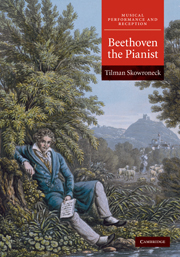Book contents
- Frontmatter
- Contents
- Acknowledgments
- Abbreviations and conventions
- Introduction
- PART I BEETHOVEN, HIS PLAYING, AND HIS INSTRUMENTS
- Introduction
- 1 Beethoven's early training
- 2 Beethoven the pianist
- 3 Beethoven's first decade in Vienna
- 4 The 1803 Érard grand piano
- PART II SOUND IDEAL AND PERFORMANCE
- PART III SOUND IDEAL, NOTATION, AND STYLISTIC CHANGE
- Epilog
- Bibliography
- Index
4 - The 1803 Érard grand piano
from PART I - BEETHOVEN, HIS PLAYING, AND HIS INSTRUMENTS
Published online by Cambridge University Press: 06 July 2010
- Frontmatter
- Contents
- Acknowledgments
- Abbreviations and conventions
- Introduction
- PART I BEETHOVEN, HIS PLAYING, AND HIS INSTRUMENTS
- Introduction
- 1 Beethoven's early training
- 2 Beethoven the pianist
- 3 Beethoven's first decade in Vienna
- 4 The 1803 Érard grand piano
- PART II SOUND IDEAL AND PERFORMANCE
- PART III SOUND IDEAL, NOTATION, AND STYLISTIC CHANGE
- Epilog
- Bibliography
- Index
Summary
HISTORY OF THE INSTRUMENT
The first decade of the nineteenth century was a period of substantial change for Beethoven: he fundamentally re-formulated his goals in composition. At the same time his health, particularly his hearing, was causing him more and more problems. The consequences of this development on his pianism and piano writing are complex and difficult to understand. Luckily, one of his private pianos from this period is preserved, and Beethoven scholars and organologists have been able to piece some of its history together. This is the grand piano by Érard, which he received in 1803.
The Érard piano has a keyboard compass of five-and-a-half octaves and an English-style hammer action. Around the time of its arrival, Beethoven extended the compass of some of his keyboard works, so a direct link between his compositions and this piano would seem self-evident. However, this instrument has received less attention in the literature than could be expected, mainly because the Érard, modern at the time of its arrival, quickly became outdated. Consequently, Beethoven expressed his disappointment with it in unequivocal terms only a few years after its arrival. William Newman writes of the Érard piano: “Beethoven was unhappy with this instrument from the start,” partly because he found its English action to be “incurably heavy.”
- Type
- Chapter
- Information
- Beethoven the Pianist , pp. 85 - 116Publisher: Cambridge University PressPrint publication year: 2010



